Constant Contact Review
Campaign Management/Creation
Constant Contact’s drag-and-drop templates are generally easy to use and offer enough customization to give your emails a branded look. You can tweak each block to suit your style, which is a plus. That said, aligning everything perfectly can sometimes be a bit challenging—especially when trying to place a colored text box under a full-width image. It might take a couple of tries to get it just right.
The platform does offer a nice range of options, whether you want to start from scratch, use prebuilt templates, or even code your own email, which adds flexibility to the design process.
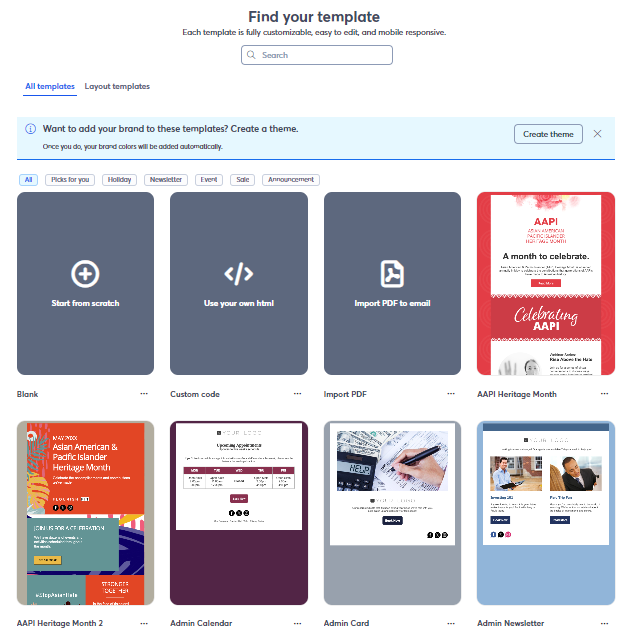
One notable feature is the ability to retain brand colors within the builder, which saves time by eliminating the need to repeatedly input hex codes. Additionally, the navigation block option is a unique offering not commonly found in other email marketing platforms, making it particularly useful for creating more dynamic email designs.
However, a downside is that custom code cannot be added directly into the drag-and-drop templates. Users must switch to a custom code template and build the entire email from scratch, which can be inconvenient for making small tweaks. Despite this, there are plenty of prebuilt templates to choose from, or users can start fresh with customizable section blocks, providing a range of design options.
The platform also offers the ability to use Google fonts and adjust colors and images, allowing for further personalization. The AI-assisted content creation feature is an interesting addition, offering quick brainstorming ideas, though it’s not flawless and may require some adjustments.
One area that needs improvement is the mobile version of their templates. While the desktop versions generally appear polished, the mobile view can be inconsistent—an important factor given the number of users who open emails on their phones.
Additionally, there is no dedicated section for saving templates. Users must copy an existing campaign to reuse content, which isn’t the most efficient method.
Pros:
- User-friendly drag-and-drop templates with customizable blocks.
- Brand color retention for time-saving design consistency.
- Unique navigation block option compared to other platforms.
- Variety of prebuilt templates and the flexibility to start from scratch.
- Google fonts and image customization allow for a personalized touch.
- AI-assisted content creation for generating quick ideas.
Cons:
- Aligning elements perfectly can be tricky at times.
- No option to add custom code directly into drag-and-drop templates.
- Some mobile template designs need improvement.
- No designated section for saved templates; copying old campaigns is the only option.
Resources

Constant Contact allows users to upload their own images, similar to most platforms, but what really stands out is its extensive library of stock images and the ability to connect a Canva account. For those who already use Canva for their designs, this integration is incredibly convenient. Users can even add images from URLs if they are hosted elsewhere, though this option doesn’t seem to be widely utilized.
One downside is the lack of guidelines for recommended image sizes within the editor, which can be frustrating for users unsure of the optimal dimensions for their images.
Another appealing feature is the ability to create events and surveys, which can be embedded directly into emails or sent out as standalone items. While managing RSVPs and data requires a few extra steps, this functionality remains very handy. Users can also upload PDFs and link to them in their emails, making it easy to share additional content. Additionally, the customizable coupon block in the drag-and-drop editor simplifies promoting special offers effectively.
Pros:
- Flexible image options: users can upload their own, utilize stock images, or incorporate Canva designs.
- The option to use image URLs is available, though it’s not commonly used.
- Ability to create events and surveys, either embedded in emails or as standalone items.
- Uploading PDFs and linking them in emails provides a nice way to share additional content.
- The customizable coupon block serves as an effective tool for promotions.
Cons:
- There are no recommendations for optimal image sizes within the editor.
- Managing RSVP data or survey responses involves a few additional steps.
Automations/Drip Campaigns
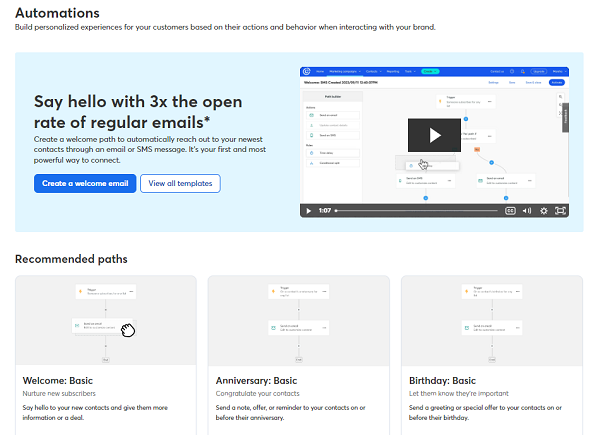
Constant Contact’s automation features are comparable to those found in other platforms. Users can easily set up basic workflows, such as welcoming new subscribers, sending birthday messages, or creating simple drip campaigns. However, to fully leverage these automations, users often require the right integrations and a higher-priced plan, which can be a drawback. There is certainly a learning curve involved, and since Constant Contact only knows the data users input, setting everything up correctly is crucial for success.
The platform integrates well with many eCommerce solutions, making it easy to track sales generated from automated emails. Additionally, users can employ segmentation to customize their automations, but it’s essential to have a clear strategy in place to utilize this feature effectively.
Pros:
- Versatile automation options for welcoming subscribers, nurturing leads, and celebrating special occasions.
- Strong eCommerce integration simplifies the tracking of sales from automated campaigns.
- Segmentation enables more precise targeting within automations.
Cons:
- There is a learning curve to ensure everything is set up correctly.
- Users need to understand which criteria to apply for effective segmentation.
- Many advanced automation features are restricted to higher-tier plans.
Segmentation

Constant Contact provides numerous possibilities for audience segmentation, though the options available depend on the plan users choose. Higher-priced plans unlock additional features, which is an important consideration. Similar to the automation capabilities, Constant Contact relies on the information users provide, so having the right integrations for auto-populating lists or being meticulous about uploaded data is essential.
Users can utilize fields or tags to create segments, offering considerable flexibility. This feature proves to be very useful for targeting specific groups effectively.
Pros:
- Many ways to segment the audience if there is sufficient data available.
- The ability to use fields or tags adds significant flexibility.
- More advanced segmentation features are accessible on higher-priced plans.
Cons:
- Enhanced segmentation options are tied to the more expensive plans.
- Effective auto-population of lists requires the right integrations.
- Users must manage their data carefully to ensure successful segmentation.
Statistics and Reporting
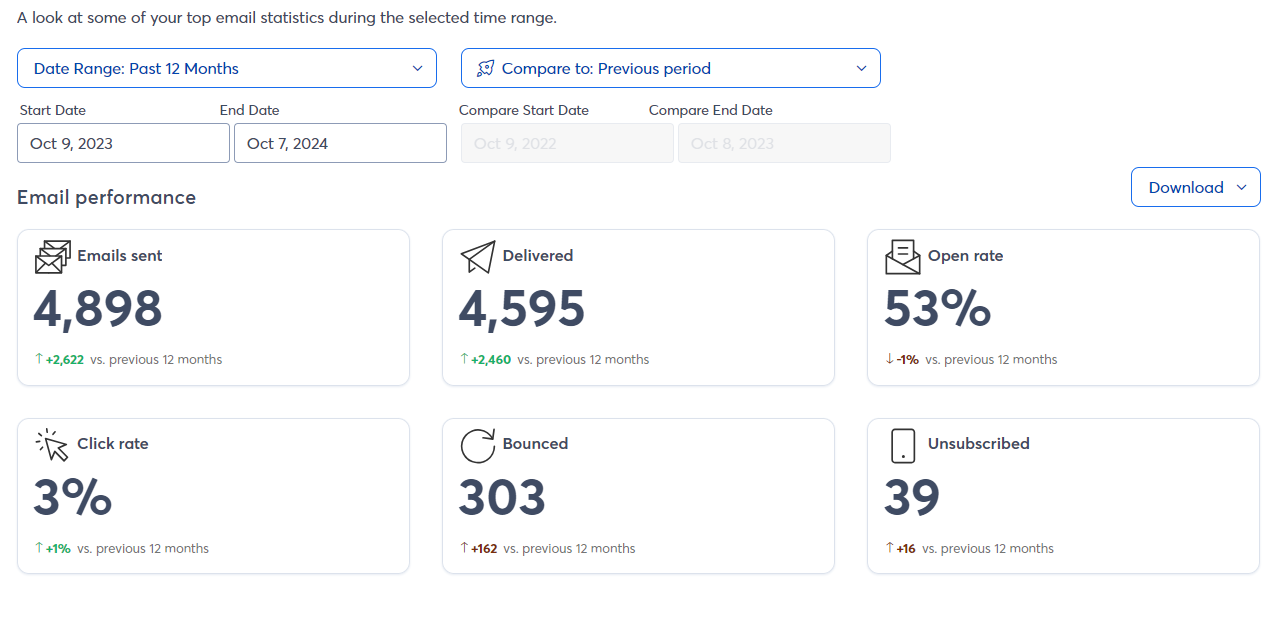
The reporting features in Constant Contact are fairly average. Users receive standard metrics such as opens, clicks, bounces, and unsubscribes, along with a breakdown of mobile versus desktop opens. However, the reliability of open rates has diminished due to the Apple Privacy Protection Policy. On a positive note, the platform does offer A/B testing, which is valuable for determining what works best in campaigns.
While the reports are straightforward and easy to understand, they remain relatively basic. There is also an option to compare campaign performance with other companies in the same industry; however, these comparisons may not always provide significant insights, as every audience has its unique characteristics.
Pros:
- User-friendly reports that are accessible even for newcomers to email marketing.
- Basic metrics, including opens, clicks, bounces, and unsubscribes, are all available.
- A/B testing is included, aiding in campaign optimization.
- Industry comparisons can be useful for context.
Cons:
- Insights provided are limited to basic metrics.
- Open rates have become less reliable.
- Industry comparisons may not be particularly beneficial for specific audiences.
User/Account Management
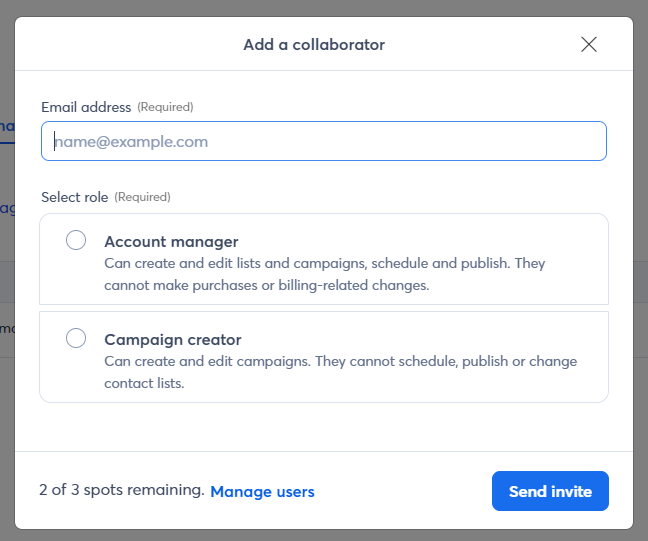
Constant Contact allows account owners to add other users as campaign creators or account managers. Campaign creators can design campaigns, but they lack the ability to send them, which means another person is needed to handle the actual sending of emails. For those managing client accounts, the partner program is a valuable feature, as it enables management through a single portal without requiring multiple logins.
However, adding new users can be somewhat tedious, and the options for setting permissions are quite limited. While partners enjoy full access, other roles have restricted capabilities, which can complicate the delegation of tasks.
Pros:
- Users can be assigned specific roles, such as campaign creators or account managers.
- The partner program facilitates the management of multiple accounts through one centralized portal.
Cons:
- The process of adding users can be cumbersome.
- There are limited options for configuring user permissions.
- Campaign creators are unable to send emails, necessitating an additional step in the process.
Integrations
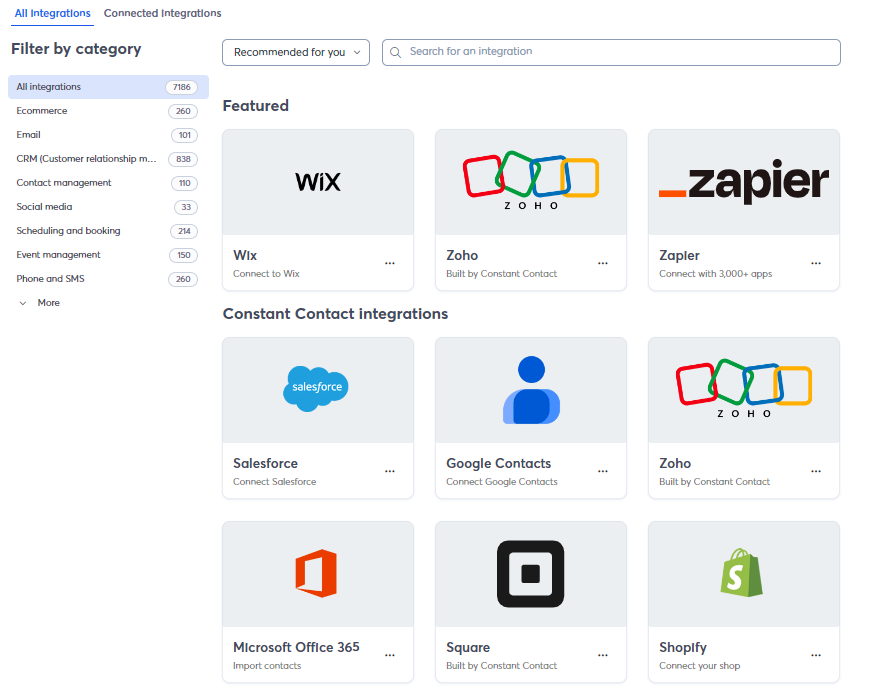
Constant Contact boasts an impressive array of integrations—around 5,000—allowing it to connect seamlessly with virtually any tool users might be utilizing. The complexity of the setup can vary significantly; while the technical details may be outside the user’s expertise, the platform is known to perform well for those who are comfortable with the setup process.
Pros:
- A wide variety of integration options with popular tools like Shopify, WordPress, and Salesforce.
- The extensive range of integrations makes it adaptable to diverse business needs.
- Developers have the flexibility to integrate nearly any application, which enhances overall usability.
Cons:
- The setup for integrations can range from straightforward to quite complex, depending on the requirements.
- Users who lack technical knowledge may find the integration setup challenging.
Support
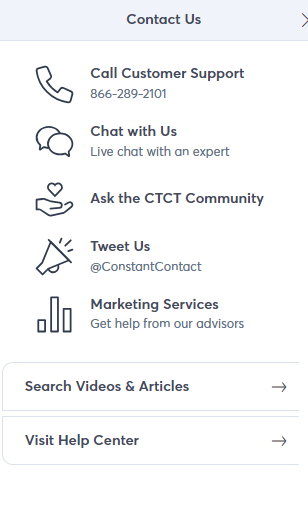
Constant Contact offers robust support options, including phone, email, and chat support. Partners benefit from a dedicated support line, which is a nice perk. Unlike many other platforms, phone support is available to all users, regardless of their plan level, making it a significant advantage.
However, it’s worth noting that phone support is not available 24/7. Additionally, the general customer service representatives may not always possess the same level of expertise as those on the partner support team.
Pros:
- A variety of support options, including phone, email, chat, community forums, and a knowledge base.
- Dedicated support lines for partners enhance their experience.
- Phone support is accessible to all users without requiring a premium plan.
- Assistance is available for building templates to help users get started.
Cons:
- Phone support does not operate 24/7.
- Standard customer service may lack the expertise found in partner support.
Pricing
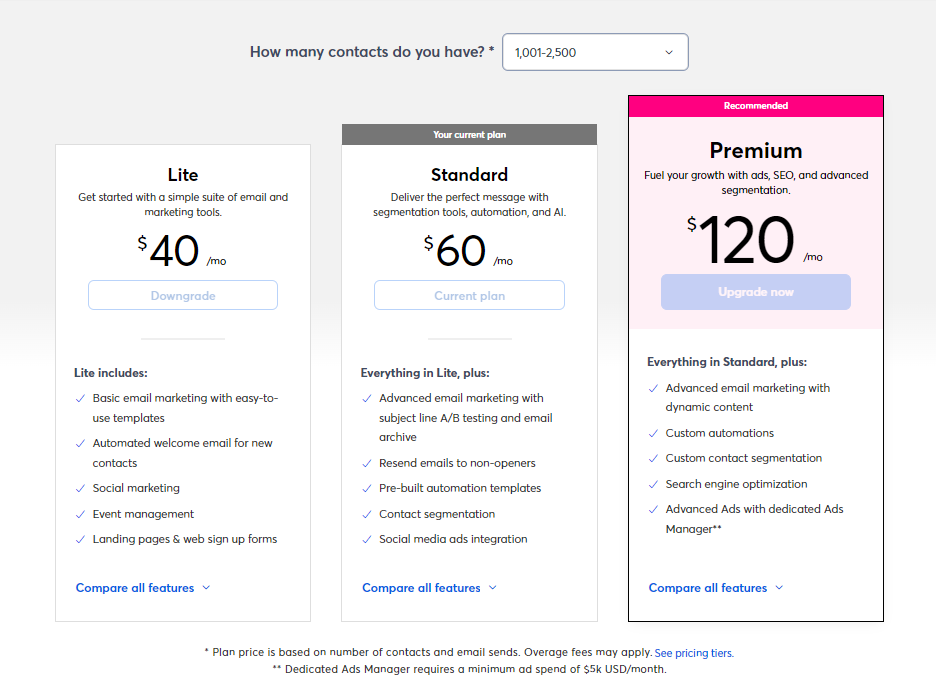
Constant Contact’s pricing structure is based on the number of contacts, offering three tiers: Lite, Standard, and Premium. Users should be mindful that unsubscribed and non-opt-in contacts continue to count toward the contact limit unless manually removed. This can lead to higher-than-expected costs, especially if users have a large list with many unengaged contacts. While the Lite plan is quite affordable, it comes with limited features, and users may find themselves needing to upgrade to the Standard or Premium plans to access essential tools like advanced automations or integrations.
As the contact list expands, costs can escalate quickly, particularly for features like A/B testing, segmentation, or integrations, which are only available at the higher tiers. Overall, Constant Contact’s pricing aligns with other email marketing platforms, but the perceived value will largely depend on how effectively users leverage the tools provided at their chosen plan level.
Pros:
- Lite, Standard, and Premium plans are available to suit various needs and budgets.
- The Lite plan is relatively affordable, making it accessible for small businesses.
- Transparent pricing structure based on the number of contacts helps users plan accordingly.
Cons:
- Unsubscribed and unengaged contacts still count toward the limit unless removed manually.
- Many valuable features are restricted to Standard or Premium plans.
- Costs can increase significantly as the contact list grows.
Other Features
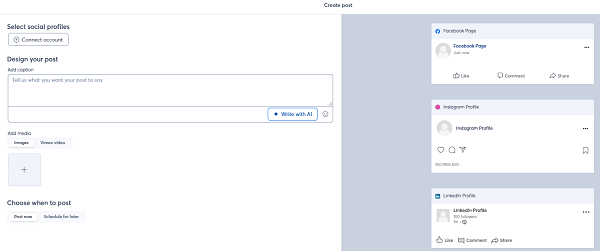
One unique feature of Constant Contact is its ability to create and manage social media posts directly within the platform. Users can schedule posts for Facebook, Instagram, Twitter, and LinkedIn, which is beneficial for streamlining marketing efforts. However, the scheduling feature is somewhat basic when compared to dedicated social media management tools.
Another noteworthy feature is the intuitive landing page builder, which integrates seamlessly with email campaigns. This integration makes it easy to create a cohesive experience from email to landing page. Additionally, the option for shoppable landing pages is particularly advantageous for product-based businesses.
Constant Contact also offers a relatively new SMS marketing feature that allows users to send texts to contacts alongside emails. This addition provides a more direct communication channel, especially useful for special offers or time-sensitive messages.
Conclusion
Overall, Constant Contact presents a solid choice for small to mid-sized businesses seeking an easy-to-use email marketing solution. The platform’s drag-and-drop builder, Canva integration, and event management tools stand out, making it convenient for creating and managing campaigns without requiring extensive technical knowledge.
However, users should be aware of the limitations in automation, segmentation, and customization if their marketing needs are more sophisticated. Pricing can escalate quickly as the contact list grows, particularly for features available only in the higher-tier plans.
Constant Contact is ideal for those looking for a platform that combines email, landing pages, social posting, and SMS in one place—especially if advanced functionalities are not a priority. While it may not be the perfect solution for everyone, it is certainly worth considering for users who prioritize ease of use and convenience.
